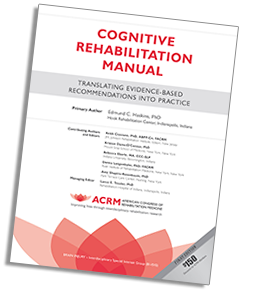Bring ACRM Training to Your Facility
Doesn’t your WHOLE TEAM need to know the latest evidence-based interventions for cognitive impairment? Now you can bring the same two-day Cognitive Rehabilitation Training, offered at ACRM Conferences, to your facility.
REQUEST A QUOTE >>
Or contact Member Services, +1.703.435.5335 for full details.
EVIDENCE-BASED TRAINING
After an exhaustive review of the scientific literature, led by Keith Cicerone, PhD, ABPP-Cn, FACRM, members of the ACRM Brain Injury Interdisciplinary Special Interest Group (BI-ISIG) developed the ACRM Cognitive Rehabilitation Manual: Translating Evidence-Based Recommendations into Practice, making research outcomes accessible for use in everyday clinical practice like never before. This two-day workshop provides an extraordinary opportunity to learn all of the recommended evidence-based strategies for cognitive rehabilitation from leading researchers and clinicians in the field.
This introductory training teaches evidence-based interventions for impairments of:
- Executive functions
- Memory
- Attention
- Hemispatial neglect and
- Social communication
REGISTRATION INCLUDES:
- TWO DAYS of live training
- THE MANUAL: One printed copy of the ACRM Cognitive Rehabilitation Manual (150 pages PLUS worksheets—$150 Value)
- 12.5 hours of continuing education. CME/CEUs available in your choice of 10 disciplines
- ONLINE COURSE: 6 months access to a previously recorded Cognitive Rehabilitation Training ($395 value)
- Non-member registration includes a 6-month introductory ACRM membership, including access to all interdisciplinary special interest groups and networking groups.
WHO SHOULD ATTEND?
- Occupational therapists
- Speech-language professionals
- Psychologists and Neuropsychologists
- Physicians
- RN/Rehab Nurses
- Disability management specialists
- Caregivers who want to know the science supporting rehabilitation treatment
ALL rehabilitation professionals striving to deliver the latest evidence-based interventions for cognitive rehabilitation.
 THE MANUAL: A “MUST-HAVE” RESOURCE
THE MANUAL: A “MUST-HAVE” RESOURCE
The Manual is ideally suited for clinicians who have had some formal training in cognitive rehabilitation, and who have experience working with individuals with brain injury (e.g., traumatic brain injury, stroke). The step-by-step interventions described can be readily used by occupational therapists, speech and language therapists, psychologists, and other rehabilitation professionals.
The Brain Injury Interdisciplinary Special Interest Group (BI-ISIG) of the American Congress of Rehabilitation Medicine (ACRM) is committed to fostering the use of empirically supported interventions to improve the lives of individuals with brain injury. A series of reviews, which are published in the Archives of Physical Medicine and Rehabilitation (Cicerone et al., 2000; 2005; 2011) have reviewed the scientific literature and put forth standards and guidelines for clinical practice based on the quality of evidence available for each intervention.
The Cognitive Rehabilitation Manual operationalizes or “translates” these guidelines into step-by-step procedures that can be used by clinicians who treat individuals with brain injury.
The volume is organized into six chapters. The introductory chapter compiles the clinical wisdom of the authors into a practical roadmap for structuring and implementing cognitive rehabilitation interventions. Treatment considerations and patient factors that may influence the course of treatment are discussed, and a guide to goal-setting that is applied throughout the manual is introduced.
Subsequent chapters present practical guides for the implementation of evidence-based interventions for impairments in each of the following areas: Executive Functions, Memory, Attention, Hemispatial Neglect, and Social Communication.
The content of each chapter draws from empirically-supported rehabilitation interventions included in the Cicerone et al. reviews (2000; 2005; 2011) and the collective clinical experience of the authors of the Cognitive Rehabilitation Manual. Wherever possible, step-by-step guidelines for implementing each intervention and setting relevant individual goals are provided, along with clinical recommendations for tailoring and modifying the intervention according to patients’ needs.
In cases where in-depth treatment manuals exist, full references and links to these materials are provided. Additional appendices include rubrics for goal-setting in each of these domains of functioning, and handouts or worksheets that can be used to record and evaluate progress.




